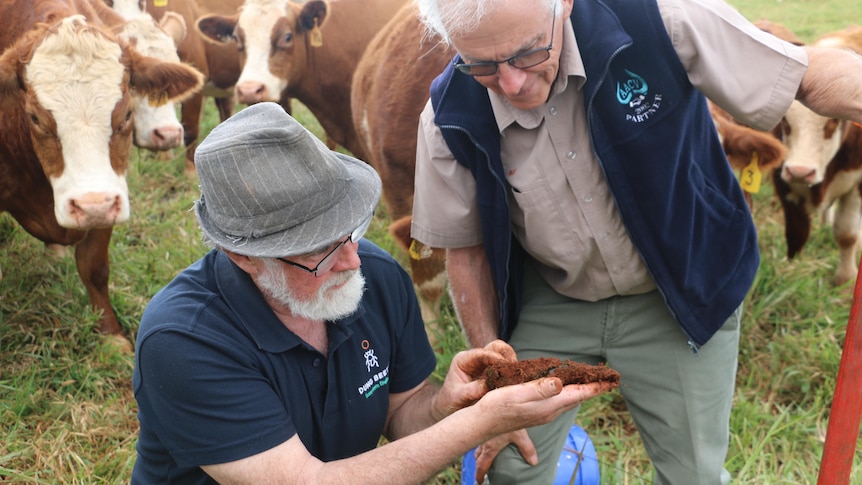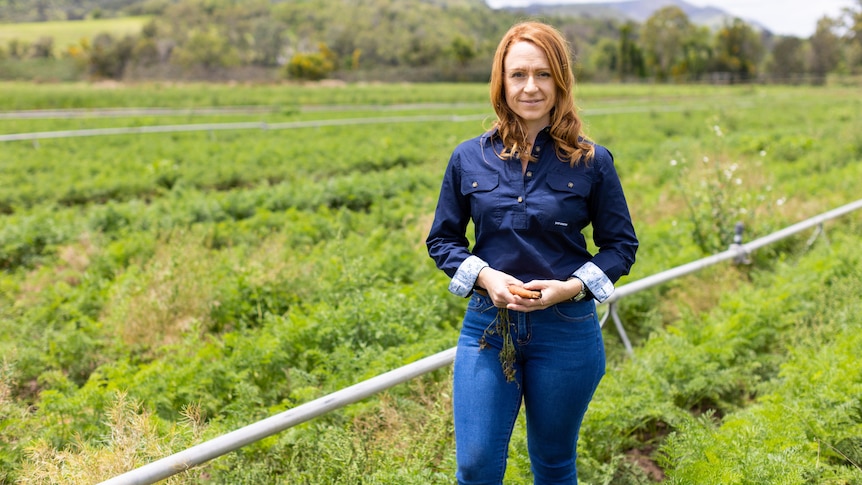A passing observer might think the cattle and dairy farmers of far north Queensland have been having very strangely by digging through their paddocks — elbows deep in cattle dung.
Key points:
- The natural activity of dung beetles improves soil quality and reduces effluent pollution
- Far north Queensland farmers are researching which species are best suited for the region
- Farmers plan to import another species after identifying 13 species on the Atherton Tablelands
They are on the hunt for an insect that has one of the most unappealing and yet important jobs in the world: eating animal droppings.
Their search comes as soaring fertilizer prices and workforce shortages across Australia accelerate a movement towards natural, non-labor intensive alternatives.
The humble dung beetle offers a real solution.
It recycles effluent waste into organic fertilizer, eradicates flies, aerates the soil and increases water penetration — all while cheerfully munching on dung and asking nothing in return.
Beetles that specialize in eating cattle dung have been studied and bred extensively in both southern Queensland and southern states since they were introduced by the CSIRO in the 1970s.
But until now, there have not been any comprehensive long-term studies on how to breed and propagate species suited to northern Australia.
Some 15 farmers in far north Queensland have rolled up their sleeves to find out just what is living in the cow pats on their fields.
Cattle dung ‘attracts flies’
Among the participants is Gail Abernethy, who runs a small herd of cattle at a 36-hectare property at Wondecla on the Atherton Tablelands with her husband Victor.
She said she wanted to increase the population of dung beetles in the region, not only to reduce pasture fouling and fly outbreaks, but also to benefit productivity and the environment.
“There are native dung beetles, but they eat marsupial dung, so before the CSIRO back in the 70s and 80s introduced dung beetles from overseas, there was a lot of dung on the ground because it wasn’t being processed,” Ms Abernethy said .
“Cattle dung attracts flies, and that’s why the Australians had the fly salute, and had corks on their hats because there were so many flies.”
Ms Abernethy said dung beetles took the manure and buried it, which improved soil quality and created aeration of the soil, “so you’ve got less run-off from rainwater.”
“But there’s so little research and development being done in northern Australia, where all the cattle live,” she said.
A dung beetle for every season
Ms Abernethy began ordering dung beetles from southern breeders in 2014, but soon realized there was very little information about what species survived well in northern Australia at different times of year.
She and 14 other farmers obtained a Landcare grant to undertake their own research — and they have not been afraid to get their hands dirty.
“You take your shovel and you find a cow pat that’s at least 24 hours old, and put it in your bucket with some soil, and then empty some water into it, and they will float to the top in a graceful style,” Ms Abernethy said.
“We have collected beetles once a month for 12 months, and we now know we have nine separate species of introduced dung beetles and four predatory species.
“They’re the smaller ones who eat the fly larvae … and some of our beetles don’t live down south. They’re just up here in the tropics.”
Creating plant nutrients
South Australia’s Dr Bernard Doube is among the world’s leading dung beetle ecologists and is helping the group with beetle identification.
He said the study had revealed a particularly abundant population of one species of dung beetle, Onitis vanderkelleniwhich was thriving in the Atherton Tablelands.
“It’s got a very restricted distribution up here and hardly anywhere else in Australia, but up here, it’s doing a great job,” Dr Doube said.
“It digs a tunnel to about 20 centimetres and lines the tunnel with dung … and down below, the beetle puts perhaps half a liter of dung, a huge amount really, and lays a whole [lot] of eggs in it.
“The eggs hatch into larvae, and the larvae eat all of the dung, and then [produce] all this processed stuff, which is rather like compost.”
Dr Doube said it created a “great big pile of plant nutrients”.
“The roots grow down there, and you get increased production and increased carbon storage because it’s a relatively permanent change in the structure of the soil,” he said.
“And our experiences from southern Australia indicate that we get about a 30 per cent increase in productivity due to the dung burial activity of the beetles.”
Importantly, Dr Doube said the study had also revealed a gap in the winter population of dung beetles.
“What this project has shown is that we have quite a diversity of beetles here, and they are active during the summer,” he said.
“But at this time of the year in autumn and winter, although there are some beetles present and they’re burying dung, they’re not very common.”
Dr Doube said the group would now seek further funding to import and breed a species of beetle called Onitis caffer, which was more active during autumn and spring.
“We hope that we can get some financial support to establish a dung beetle importation program again, bringing in this particular beetle, which is going to be most beneficial, in my view,” he said.
.

